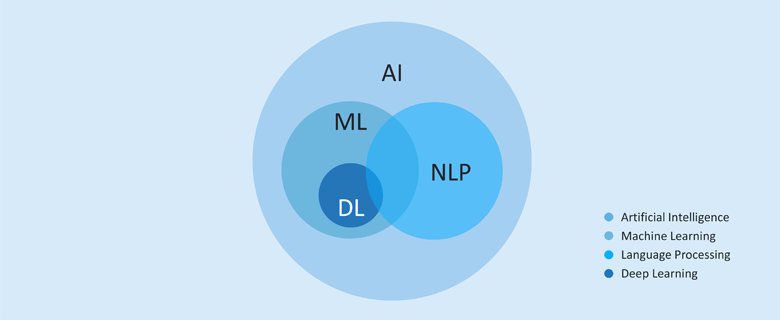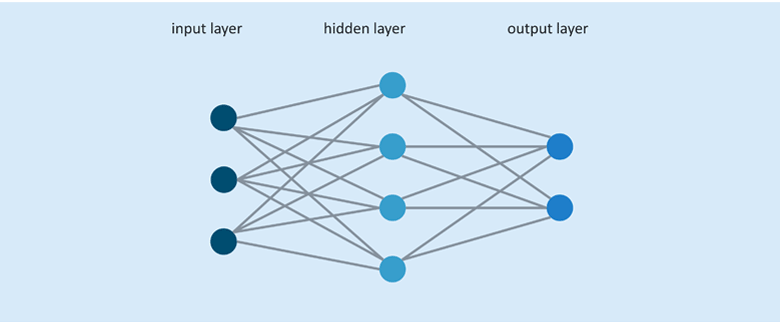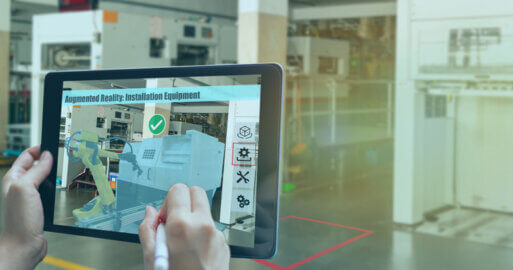Artificial Intelligence and The SEEBURGER BIS

Artificial intelligence is playing an ever greater part in our everyday lives. Intelligent systems are behind ever more processes and decisions which affect us day to day. The importance of intelligent processes and systems is also increasing in the B2B sector and will be essential to companies’ success in the future. But what exactly is artificial intelligence? And how can companies use AI to optimise their processes and explore new business areas? Let’s find out more.
Artificial intelligence and machine learning
In computer science, the term artificial intelligence (AI) refers to the development of intelligent systems and processes. The aim is to emulate human intelligence and to develop programs that solve problems independently without being explicitly programmed to do so.
Artificial intelligence is a large field in computer science, and is divided into different subfields. These include natural language processing (NLP), machine learning (ML) and deep learning (DL). For each of these areas, there are different methods and techniques to solve problems.

Natural Language Processing
Natural Language Processing (NLP) aims to understand and process natural, human language. Since computers are generally unable to understand natural language, various techniques are used to convert it into a machine-readable format and make it usable.
After the data has been converted into a machine-readable format, it can be used to solve various problems. As well as having a corpus of language at our disposal, NLP often forms the basis of other technologies.
Nowadays, NLP is used in a number of programs and systems to improve a machine’s understanding of natural language. Common areas include:
- E-mail spam filter
- Automated ticketing
- Sentiment analysis (opinion mining)
Machine Learning
Learning systems are an essential part of artificial intelligence and are collectively referred to as machine learning. The aim is to train algorithms to recognize rules and patterns in data and apply these to complete tasks.
To begin with, the algorithms are given training data to learn the patterns and rules within that data. The systems then adapt and improve the algorithms. This knowledge can later be used to solve problems on real data. As a rule we differentiate between different types of machine learning:
Supervised learning
Supervised learning trains an algorithm using prepared sample data. The input data contains markers which define the output. The goal is for the algorithm to learn to predict the output based on the input. Supervised learning is typically used for classification tasks, such as image recognition. The algorithm is given a picture as input and a classification as output. This lets the algorithm learn whether, for example, a picture is of a cat or a dog.
Unsupervised learning
In unsupervised learning, there is no labelled training data. Instead, the model needs to learn to recognise patterns itself. This type of model is usually used for cluster analysis, in which data is classified into groups. In marketing, for example, you may wish to put customers into meaningful groups to tailor advertising.
Semi-supervised learning
As well as supervised and unsupervised learning methods, there is also semi-supervised learning. This is a hybrid of the other two. The algorithm is trained with both marked and unmarked data. This method is used in areas in which little is known about the input data so that only a small proportion can or should be marked.
Reinforcement learning
Reinforcement learning is a reward-based machine learning method. The algorithm performs actions independently and is given feedback on whether the selected action was good or bad. This lets the algorithm find its own ways to solve an issue. This learning method is particularly known from the gaming world. Algorithms learn how to master computer games, getting better with each attempt. However, this method is also used in the less playful areas of robotics and finance.
Neural networks
Artificial neural networks are often used in machine learning. These are an attempt to create intelligent models by replicating the neurons in the human brain. The basic idea behind this approach has been around for a long time. However, it only gained traction once computing became fast and powerful enough to enable quick, cost-effective learning.
An artificial neural network consists of several layers of neurons. The individual neurons within the various layers are connected to each other. Information is passed along these links from one neuron to the other. You can also use further, hidden layers between the input and output layers.

The input layer receives the initial data and passes it on to the connections. Each connection has a specific weight or value which determines its importance. The connections pass the data on to the neurons. The neuron then multiplies the data from each connection by its respective value and aggregates the whole. An activation function is then applied to determine how much information reaches the next layer. The actual result is produced by the output layer. This result is compared to the input and the various weights are adjusted to minimise errors. The same procedure is carried out for all the training data. This means that the weights are constantly being readjusted and the model learns to recognise the correct output for each input.
Deep Learning
Deep Learning is a sub-category of ML and deals with the development of deep neural networks to solve problems. Deep neural networks have several hidden layers and are therefore significantly bigger than simple neural networks.

You need huge amounts of data to train these complex models. Their multitude of layers and their parameterised neurons enable them to learn and use several different characteristics. This is important for more complex AI areas, such as picture recognition or identifying anomalies in time series sequences.
The progress in computing power and the huge amounts of data generated these days have led to ever deeper neural networks. As well as adding more layers to neural networks, today‘s systems also use different types of architecture to solve problems in different ways. In image recognition, for example, as well as looking at the picture as a whole, the system also tries to define smaller sections of the picture and search these for specific features.
DL-based systems are used in the following areas:
- Picture recognition
- Automatic machine translation
- Identifying anomalies
Artificial intelligence in the B2B area
We already use AI every day in our business and personal lives. This ranges from facial recognition on our smartphones to translation tools such as Google Translate, to the automatic detection of credit card fraud.
Artificial intelligence is also playing a more significant role in the corporate world. AI-based systems are not only helping organisations keep costs down, they are also invaluable for creating new products and ideas and to open up new areas of business.
AI has grown in popularity in the corporate world in the last few years. It is often found in the following areas:
Marketing
In marketing, artificial intelligence has already been used for years to ensure products appeal to the right target group. Data from websites and customer databases are used to analyse customers and find the best type of customer for a specific product. This preparatory work helps ensure that a marketing campaign is successful.
Monitoring systems
The growing number of machines, systems and electronic processes in a company all require quite considerable monitoring. If this error detection and prevention were done solely by people, you would need a small army. However, machine learning means that monitoring can often be automated. Anomaly detection software, for example, lets you identify suspicious or unusual actions and report them to the right person. And this means that issues can be nipped in the bud before they damage the organisation.
Finances
Artificial intelligence has been used to detect credit card fraud for many years. The systems learn to recognise a customer’s normal buying behaviour, and are then able to flag up behaviour which deviates from this as possibly fraudulent. If an unusual purchase is made with a stolen card, this is immediately blocked to prevent further fraudulent purchases.
These are just a few examples of how AI is being used in the B2B sector. In the future, it will only become more important for companies to employ AI to help them manage their costs and generate new products and services.
AI at SEEBURGER
The SEEBURGER BIS provides optimal conditions for developing intelligent systems. As a central data hub, BIS lets you use – and monitor – all of your company’s data. This data can be checked and monitored by intelligent systems, or can then be used to train up complex models.
API management
An API gateway lets you monitor the API calls made to your organisation. This data can then be collated and transferred to and processed by AI models. SEEBURGER‘s BIS API management solution makes it easy to automate anomaly detection on all incoming and outgoing API calls.
Alongside detecting anomalies, models can also be used to predict the number of calls expected in the future. By adopting an API strategy, you can then steer the company in the right direction early on to ensure that it can handle this expected call volume.
Integrating smart services
For many organisations, integrating smart services is important for their future. The data generated by these services is particularly valuable. If you add in AI models, you can detect problems with machines at an early stage and carry out maintenance, which will avoid more serious issues later on. The SEEBURGER Business Integration Suite is a classic integration platform which is ideally suited for providing and integrating smart services.
Thank you for your message
We appreciate your interest in SEEBURGER
Get in contact with us:
Please enter details about your project in the message section so we can direct your inquiry to the right consultant.
Written by: Florian Höhn
Florian Höhn started on placement at SEEBURGER in 2013 during his degree. Since 2016, he has been working for SEEBURGER as a software developer, developing solutions for API management and API integration. He has been interested in artificial intelligence since studying for his masters, and uses the knowledge he has in this area to develop intelligent systems and products. Outside of work, Florian is a keen sportsman and enjoys spending time with family and friends.





